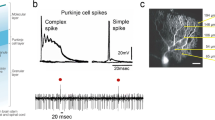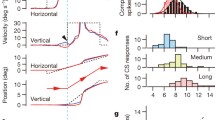Abstract.
Mean firing rates (MFRs), with analogue values, have thus far been used as information carriers of neurons in most brain theories of learning. However, the neurons transmit the signal by spikes, which are discrete events. The climbing fibers (CFs), which are known to be essential for cerebellar motor learning, fire at the ultra-low firing rates (around 1 Hz), and it is not yet understood theoretically how high-frequency information can be conveyed and how learning of smooth and fast movements can be achieved. Here we address whether cerebellar learning can be achieved by CF spikes instead of conventional MFR in an eye movement task, such as the ocular following response (OFR), and an arm movement task. There are two major afferents into cerebellar Purkinje cells: parallel fiber (PF) and CF, and the synaptic weights between PFs and Purkinje cells have been shown to be modulated by the stimulation of both types of fiber. The modulation of the synaptic weights is regulated by the cerebellar synaptic plasticity. In this study we simulated cerebellar learning using CF signals as spikes instead of conventional MFR. To generate the spikes we used the following four spike generation models: (1) a Poisson model in which the spike interval probability follows a Poisson distribution, (2) a gamma model in which the spike interval probability follows the gamma distribution, (3) a max model in which a spike is generated when a synaptic input reaches maximum, and (4) a threshold model in which a spike is generated when the input crosses a certain small threshold. We found that, in an OFR task with a constant visual velocity, learning was successful with stochastic models, such as Poisson and gamma models, but not in the deterministic models, such as max and threshold models. In an OFR with a stepwise velocity change and an arm movement task, learning could be achieved only in the Poisson model. In addition, for efficient cerebellar learning, the distribution of CF spike-occurrence time after stimulus onset must capture at least the first, second and third moments of the temporal distribution of error signals.
Similar content being viewed by others
Author information
Authors and Affiliations
Additional information
Received: 28 January 2000 / Accepted in revised form: 2 August 2000
Rights and permissions
About this article
Cite this article
Kuroda, S., Yamamoto, K., Miyamoto, H. et al. Statistical characteristics of climbing fiber spikes necessary for efficient cerebellar learning. Biol Cybern 84, 183–192 (2001). https://doi.org/10.1007/s004220000206
Issue Date:
DOI: https://doi.org/10.1007/s004220000206




